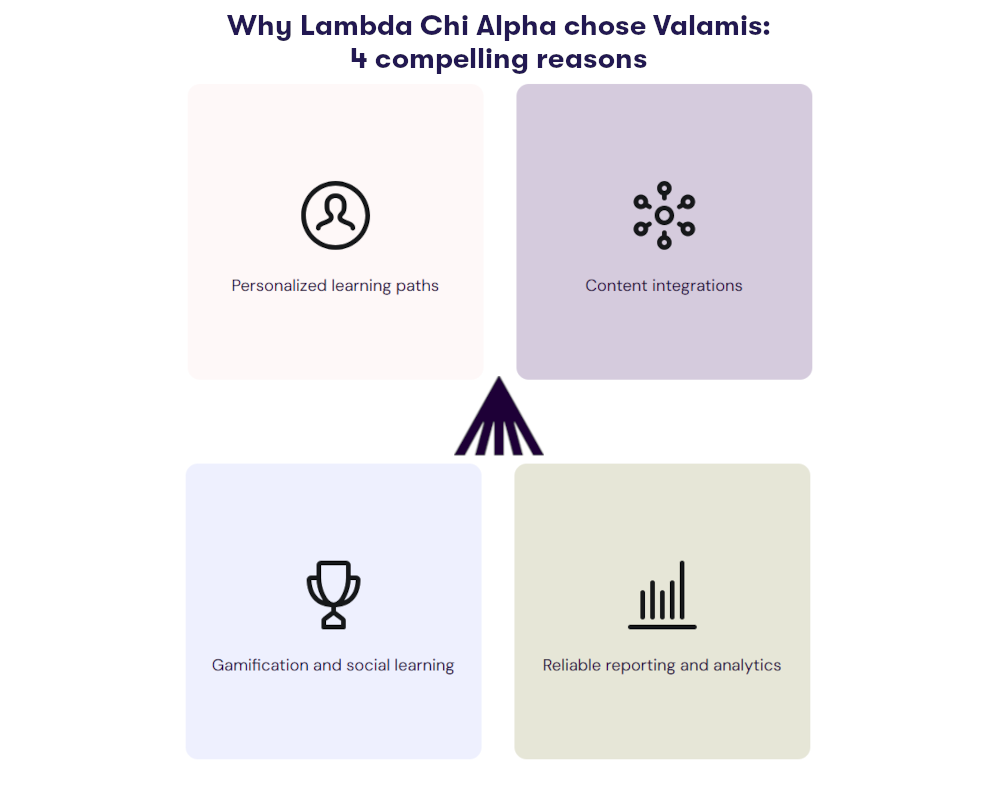5 Top L&D trends for 2025: Stay ahead with targeted strategies
Discover the top 5 Learning & Development trends for 2025, with actionable insights and tips.

As 2025 approaches, the world continues its pace of transformation, taking Learning and Development (L&D) along with it. With technology driving change and workforce expectations evolving, it is essential for HR professionals, learning managers, and business leaders to stay updated on the latest L&D trends for 2025.
In this blog we’ll cover the following:
Why 2025 is a pivotal year for L&D
The workplace has changed a lot. Hybrid work is now the new standard, mixing remote and in-office employee development, creating a flexible and dynamic work environment.
New technology has sped up this change. Organizations are continually adapting to new situations, especially in response to recent global events. Because of this, digital and soft skills are now so very important for all employees. Knowing how to use generative AI and learning platforms is no longer just a bonus but the key to success in today’s job market.
In this changing digital world, employees want more than traditional employee learning. They seek training programs that are personal and engaging. These experiences should be easy to use and interactive, like the immersive learning apps they enjoy daily on their mobile devices.
Now, learning experiences that match individual needs and styles are expected. This demand for better, user-friendly learning is changing how companies develop their employees. Organizations that understand and adapt to these changes can attract and keep top talent.
Let’s look at the key learning and development trends that will shape the future of continuous learning and help your organization succeed.
5 Top L&D trends for 2025
Targeted upskilling: Closing skills gaps with precision
One of the biggest priorities for 2025? Targeted upskilling. Our recent survey of L&D professionals revealed that 50% are focusing on identifying and addressing specific skills gaps. Why? Because the ability to pinpoint where your teams need growth and tailor learning solutions accordingly is a competitive advantage.
Valamis LinkedIn poll results: September 2024
Organizations are moving away from one-size-fits-all training. Instead, they are embracing skills gap analysis to ensure their workforce is prepared for the challenges ahead. If you’re considering this approach, our Skills gap analysis guide can help you get started.
Forbes reported since AI and automation are driving workplace trends for 2025, organizations must prioritize continuous learning to equip their workforce with the skills needed to thrive in this new era. By fostering a culture of lifelong learning, businesses can unlock innovation and secure their competitive edge.
Gamification for enhanced engagement
Gamification isn’t just about adding fun but transforming learning into a more engaging and impactful experience. By incorporating elements like points, badges, and leaderboards, organizations can tap into the human drive for achievement and competition, improving motivation and improving outcomes.
When aligned with clear business goals, gamification helps establish a strong learning culture, uncover knowledge gaps, energize dull programs, streamline onboarding, and keep employees up-to-date on policies and products. It also creates team building, promotes positive employer branding, and ensures compliance training is effective and memorable.
Why does this matter?
- Gamification taps into the human desire for achievement and competition.
- When aligned with business goals, it enhances retention and encourages continuous learning. In 2025, learners will demand fun and engaging eLearning experiences.
eLearning Industry predicts that in 2025, there will be an increased demand for fun and engaging learning experiences. Gamification, powered by AI, will be able to deliver personalized challenges, instant feedback, and rewarding experiences. Introducing this type of learning will make learning more enjoyable and effective, ultimately boosting learner satisfaction and performance.
Valamis customers Lambda Chi Alpha and Sverok have successfully used gamification to elevate their training programs, proving its power to enhance engagement and support organizational success.

AI-driven personalized learning
AI was undoubtedly the biggest buzzword for every sector in 2024, with so much hype we have all become more savvy about the true benefits vs the over-inflated claims. AI’s current role in L&D might be limited, as reported by Fosway Group, but organizations are optimistic about its future potential. While only a quarter of organizations report significant AI impact today, over half anticipate a dramatic shift in 2025.
Using AI-powered platforms, learning teams can tailor the learning experience to each individual, making it more engaging and effective. AI analyzes learner behavior to serve up content that fits their needs, which not only encourages all-important learning engagement but also improves employee retention.
So, why should you care? With the right customization, personalized learning can increase employee engagement and knowledge retention rates dramatically.
Here’s why it matters:
- Engagement: Personalized learning paths can measurably increase employee engagement.
- Retention: Knowledge retention rates are known to improve through customized training.
This shift is so important that 76% of HR leaders warn that failing to adopt AI in L&D could leave companies struggling to keep up.
If you’re not exploring how AI can enhance your training programs, now’s the time to start! Discover how Valamis uses AI to enhance learning.

Make AI work for you: a simple guide
Insights, hints, and tips on where to start and what to do next. Perfect for organizations looking for direction.
Learn moreHybrid work and continuous learning
Hybrid work is here to stay, and it’s transforming how L&D operates. According to Gallup, over half of U.S. remote-capable employees now expect and prefer hybrid work models, so it’s time for businesses to rethink how they deliver training.
Gallup’s research shows hybrid work comes with both opportunities and challenges. On the plus side, employees report better work-life balance (76%), more efficient use of their time (64%), less burnout (61%), more freedom to decide when and where they work (57%), and higher productivity (52%). But it’s not all smooth sailing and 31% struggle with reduced access to work resources, 28% feel less connected to their organization’s culture, and 24% experience challenges with team collaboration.
The graph below breaks down these insights, a snapshot of what’s working and where organizations need to step up.

Key areas to focus on:
- Manager training: Equip managers with the skills to lead effectively in hybrid environments.
- Cohort learning: Reduce isolation through collaborative knowledge sharing.
- Hybrid-specific programs: Enhance communication and inclusivity.
Continuous learning is crucial in hybrid workplaces, ensuring teams remain connected, productive, and innovative.
Data-driven decision making
In 2025, data will undoubtedly be the backbone of smarter L&D strategies. Valamis has long championed the use of data and xAPI to inform L&D decisions, and now, with the market maturing, the spotlight on data-driven approaches has never been brighter. It’s time to fully harness the data we’re gathering from daily learning programs and put it to work. Reliable reporting and advanced learning analytics give organizations the tools to measure what’s working and adjust their programs for maximum impact. The result? Smarter, more effective learning strategies that drive real results.
Here’s what data can do for you:
- Measure learning impact: Move beyond gut feelings with actionable insights.
- Prove ROI: Link L&D investments directly to business outcomes.
- Stay competitive: Companies with strong learning cultures are 10x more likely to sustain growth.
To get started learn how to use data to make smarter learning decisions and turn learning data into a powerful driver for organizational success.

Use learning data to accelerate change
Understand learning data and receive a practical tool to help apply this knowledge in your company.
Download workbookHow to stay ahead
It’s fact, not just theory: the L&D landscape is only going to keep moving forward, and to stay competitive, organizations need to act now. Here are some actionable steps:
- Identify skills gaps: Use targeted analysis to focus your upskilling and reskilling efforts.
- Use generative AI wisely: Enhance learning efficiency and engagement with AI-powered tools.
- Adapt for hybrid work: Implement training programs tailored to hybrid environments.
- Embrace gamification: Make learning engaging and training content impactful.
Want to future-proof your L&D strategy? Explore more on how the Valamis learning management system (LMS) can help you to stay ahead of the curve.
Ready to lead in 2025?
Staying proactive in your L&D strategy isn’t just smart: it’s essential! Embrace these L&D trends to ensure your organization thrives in the years ahead. Explore our resources and take the first step toward a stronger, more agile workforce.




